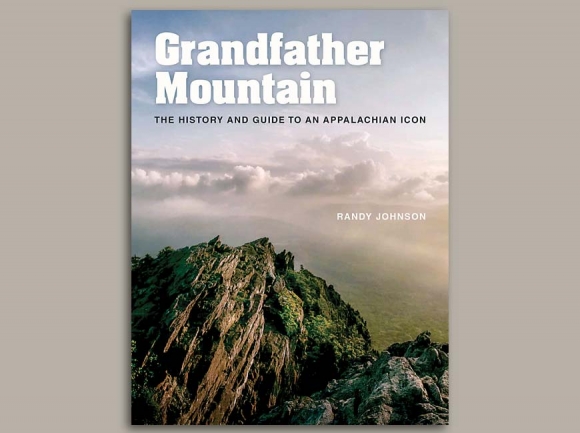Grandfather Mountain’s story makes for fascinating book

Dreamers and schemers. Andre Michaux and Daniel Boone. Yankees and Confederates. Hugh Morton. The mile-high swinging bridge. Tweetsie Railroad. Singing on the Mountain. Highland bagpipes and Low-Country vacationers. Hikers and hang gliders. Mildred the Bear. Fraser firs and rhododendron. Peregrine falcons and big-eared bats.
An unlikely combination of elements. Mix them together, however, and you’ve got one of the treasures of Western North Carolina: Grandfather Mountain.
In Grandfather Mountain: The History and Guide to an Appalachian Icon (The University of North Carolina Press-Chapel Hill, 2016, 290 pages), Randy Johnson conducts readers on a tour of the mountain, giving us a description of its geology and climate, a history of the men and women associated with it over the years, a look at the various attractions designed by some of these people to draw tourists to this peak, and a thousand bits of information in print, pictures, and photographs about the “great, evergreen Grandfather Mountain.”
Johnson divides his book into two parts. In “Part I: A History of the Mountain,” we first meet those who explored and later developed Grandfather and the land around it. One of the first Europeans to climb the mountain, French explorer and botanist Andre Michaux, whom commentator and North Carolinian Charles Kuralt once called “one of the most remarkable human beings of the 18th century, or of any century,” broke into song on reaching the peak, believing he had scaled the highest mountain in North America.
Others followed Michaux, some motivated, as was Michaux, by science and the thrills of discover. Worth “Buzz” Weller, for example, was among these visitors, a young man who in 1930 came to the mountain after his high school graduation hoping to repeat his performance of finding a new species of salamander. Weller fell while hiking at night in a storm and was found dead in Stonestack Creek. Clutched in his hand was a cloth sack containing what he had sought, a new species amphibian called in his honor Plethodon welleri, or Weller’s salamander.
Part I also tells the stories of others whom Grandfather Mountain has attracted over the last two hundred years: the settlers, the men who dreamed of making it a tourist attraction, the loggers, the railroad crews, the builders of the Blue Ridge Parkway, the conservationists. Here, too, we meet the visionary Hugh Morton, who along with other members of his family did so much to develop the mountain as a beacon for tourism.
Related Items
In “Part II: A Practical Guide to Hiking and Photography,” Johnson brings his sights to bear on the natural world of Grandfather Mountain, its hiking trails, and the best ways and means to capture its splendor in photographs. Resources in this part of the book are abundant. In the hiking section, for example, Johnson includes not only a detailed description of the trails and what sights to look for along the way, but a detailed map as well. In the short section on photography, Johnson gives camera buffs insights into the lighting around the mountain and recommendations about where to capture the best views. Johnson recommends taking “a lot of pictures,” though few will rival the number of photos snapped by Hugh Morton. An ambitious photographer, Morton left the University of North Carolina nearly a quarter of a million color slides and negatives.
With this book’s comprehensive history, its many photographs, maps, and documents, and its descriptions of the hiking trails, Randy Johnson has given us a work that does Grandfather Mountain proud.
•••
I was at the public library and looking for a collection of short stories by Breece D’J Pancake, a young Appalachian writer of short stories who in 1979 committed suicide. Pancake was a student at the University of Virginia, and I was living in Charlottesville at that time and had read some of his work. Though I didn’t find his book, the library did own another collection containing Pancake’s “The Scrapper.”
Grit Lit: A Rough South Reader (The University of South Carolina Press, 2012, 359 pages) is a gathering of short stories and excerpts from memoirs put together by editors Brian Carpenter and Tom Franklin. In addition to Pancake, Grit Lit features authors like Harry Crews, Dorothy Allison, Rick Bragg, Lewis Norden, Ron Rash, and Lee Smith.
Over the years, I have read several of these writers, so I doubt I will take up this collection. I did, however, get a kick out of Tom Franklin’s preface “What’s Grit Lit?” and wanted to share his definition of “grit lit” with readers of this column. Here’s just a part of what he wrote about the fictional characters featured in Grit Lit:
“Yes, they drink. They smoke — weed and pills and sometimes meth. They’re usually white, usually rednecks. Snopesian. Broke, divorced, violent — they’re not good country people. Writer Tony Earley divides Southern literature into two groups: those on the right side of the tracks, who sip mint juleps in Miss Welty’s yard, swearing politely under the magnolias in seersucker suits; and those on the wrong side of the tracks, whose characters make shine, shoot or stab one another on occasion, and cruise around in their pickups tossing beer bottles along the side of the road while looking for armadillos to flatten.”









